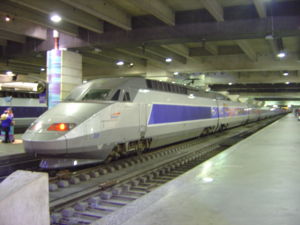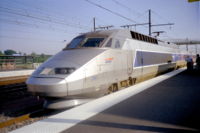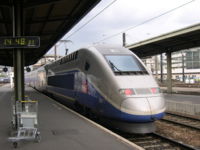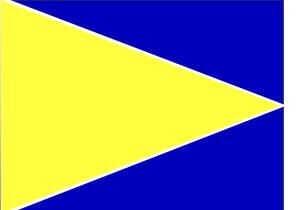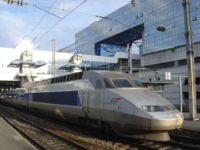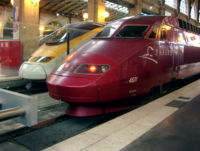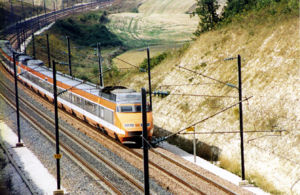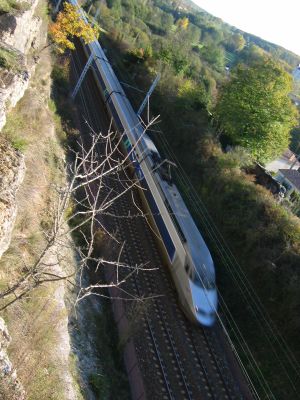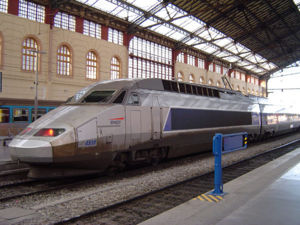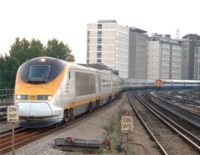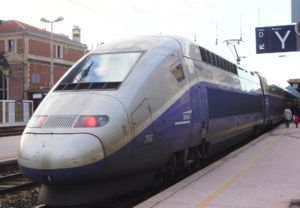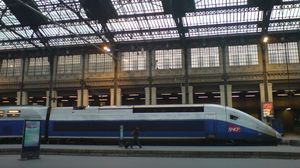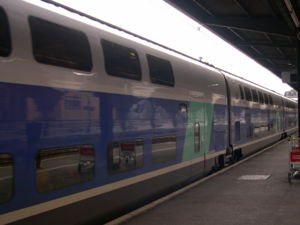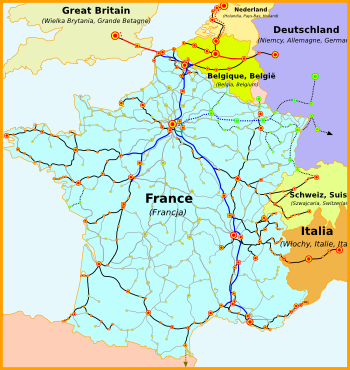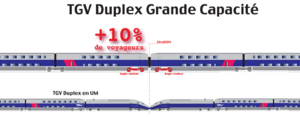TGV
The TGV (train à grande vitesse, French for "high-speed train") is France's high-speed rail service developed by GEC-Alsthom (now Alstom) and SNCF, the French national rail operator, and operated primarily by SNCF. Following the inaugural TGV service between Paris and Lyon in 1981, the TGV network, centred on Paris, has expanded to connect cities across France and in adjacent countries. It holds the record for the fastest wheeled train, and the highest average speed for a regular passenger service.
The success of the first line led to a rapid expansion of the service, with new lines built to the south, west and northeast of the country. Eager to emulate in the success of the French network, neighbouring countries such as Belgium, Italy and Switzerland have built their own high-speed lines. TGVs link with Belgium, Germany and the Netherlands through the Thalys network, and Eurostar links France and Belgium with the United Kingdom. Several lines are planned, including extensions within France and to surrounding countries. Towns such as Tours have become a part of a "TGV commuter belt".
TGVs travel at up to 320 km/h (200 mph) in commercial use (over 550 km/h (340 mph) on test runs), which is made possible through the use of specially designed LGVs (lignes à grande vitesse, high-speed lines) without sharp curves, high-powered electric motors, low axle weight, articulated carriages and in-cab signalling (eliminating the need for drivers to view lineside signals at high speed).
TGVs are manufactured primarily by Alstom, now often with the involvement of subcontractor, such as Bombardier. Except for a small series of TGVs used for postal freight between Paris and Lyon, TGV is primarily a passenger service. Trains derived from TGV designs operate in South Korea (KTX) and Spain (AVE).
Travel by TGV has largely replaced air travel between connected cities, due to shorter travel times (especially for trips taking less than three hours), reduced check-in, security and boarding formalities, and the convenient location of stations in the hearts of cities. The TGV is a very safe mode of transport, with no recorded fatalities at high speed.
History
The idea of the TGV was first proposed in the 1960s, after Japan had begun construction of the Shinkansen in 1959. At the time the French government favoured new technologies, exploring the production of hovercraft and maglev trains such as Aérotrain. Simultaneously, SNCF began researching high speed trains that would operate on conventional track.
It was originally planned that the TGV, then standing for très grande vitesse (very high speed) or turbine grande vitesse (high speed turbine), would be propelled by gas turbine-electric locomotives. Gas turbines were selected for their small size, good power-to-weight ratio, and ability to deliver high power over an extended period. The first prototype, TGV 001, was the only TGV constructed with this engine - following the increase in the price of oil during the 1973 energy crisis, gas turbines were deemed impractical and the project turned to electricity from overhead lines. The electricity was to be generated by France's new nuclear power stations.
TGV 001 was not a wasted prototype. Its gas-turbine powerplant was only one of many technologies for high-speed rail travel. It also tested high speed brakes, needed to dissipate the large amount of kinetic energy of a train at high speed, high speed aerodynamics and signalling. It was articulated, meaning that its two carriages shared a bogie between them, which allowed them to move freely with respect to one another. It reached 318 km/h (198 mph), which remains the world speed record for a non-electric train. Its interior and exterior were styled by British-born designer Jack Cooper, whose work formed the basis of all subsequent TGV design, including the distinctive nose shape of TGV power cars.
Changing the TGV to electric traction required a significant design overhaul. The first electric prototype, nicknamed Zébulon, was completed in 1974, testing features such as innovative body mounting of motors, pantographs, suspension and braking. Body mounting of motors allowed over 3 tonnes (2.95 long tons) to be eliminated from the the power cars. The prototype travelled almost 1,000,000 km (621,000 miles) during testing.
In 1976 the French government funded the TGV project, and construction of the LGV Sud-Est, the first high-speed line (ligne à grande vitesse), began shortly afterwards. The line was given the designation LN1, Ligne Nouvelle 1 (New Line 1).
After two pre-production trainsets (nicknamed Patrick and Sophie) had been tested and substantially modified, the first production version was delivered on 25 April 1980. The TGV service opened to the public between Paris and Lyon on 27 September, 1981. The initial target customers were businesspeople travelling between those two cities. The TGV was considerably faster than normal trains, cars, or airplanes. The trains became popular outside their target market. The public welcomed fast and practical travel between cities.
Since then, further LGVs have opened in France, including the LGV Atlantique (LN2) to Tours/Le Mans (construction begun 1985, in operation 1989); the LGV Nord-Europe (LN3) to Calais and the Belgian border (construction begun 1989, in operation 1993); the LGV Rhône-Alpes (LN4), extending the LGV Sud-Est to Valence (construction begun 1990, in operation 1992); and the LGV Méditerranée (LN5) to Marseille (construction begun 1996, in operation 2001). The LGV Est from Paris to Strasbourg is under construction. High speed lines based on LGV technology connecting with the French network have been built in Belgium, the Netherlands and the United Kingdom.
The Eurostar service began operation in 1994, connecting continental Europe to London via the Channel Tunnel with a version of the TGV designed for use in the tunnel and in the United Kingdom. The line used the LGV Nord-Europe in France from the outset. The first phase of the British high speed line, the Channel Tunnel Rail Link, was completed in 2003. The project, built with SNCF expertise, is due for completion in 2007, and London-Brussels will take 2 hours and London-Paris 2h15.
The TGV was the world's second commercial high speed service, after Japan's Shinkansen, which first connected Tokyo and Osaka on 1 October 1964. The TGV currently holds the world speed record for conventional, non-maglev trains. In 2007 a modfied SNCF TGV POS reached 553 km/h (343.75 mph) under test conditions, on the LGV Est. By doing so, it beat the 1990 world speed record, 515.3 km/h (320.2 mph), set by a shortened train (two power cars and three passenger cars). It was at the time the world's fastest conventional scheduled train. More recently, a typical journey's average start-to-stop speed was 263.3 km/h (163.6 mph).[1]. The TGV also broke an endurance record travelling from Calais to Marseille (1067.2 km) in 3h29 for the LGV Méditerranée inauguration on May 26th 2001.
On November 28 2003 the TGV carried its one-billionth passenger, second only to the Shinkansen's five billionth passenger in 2000. The two-billion mark is expected to be reached in 2010.
During a test run on February 13 2007, a TGV reached on 554,3 km/h (344.4 mph) under test conditions with a shortened train on the LGV Est near Passavant-en-Argonne (Marne), 190 km east of Paris. This is the world's fastest conventional scheduled train. The test was part of an extensive research programme by Alstom.[2][3]
Tracks
- Further information: LGV construction
LGVs allow speeds of up to 320 km/h (200 mph) in normal operation on the newest lines. Originally, LGVs were defined as lines permitting speeds greater than 200 km/h (125 mph); this guideline was subsequently revised to 250 km/h (155 mph). TGVs also run on conventional track (lignes classiques), at the normal maximum safe speed for those lines, up to a maximum of 220 km/h (137 mph). This is an advantage that the TGV has over, for example, magnetic levitation trains, as TGVs can serve many more destinations and can use city-centre stations (as in Paris, Lyon, and Dijon). They now serve around 200 destinations in France and abroad.
Track design
LGV construction is similar to that of normal railway lines, but with a few key differences. The radii of curves are larger so that trains can traverse them at higher speeds without increasing the centrifugal force felt by passengers. The radii of LGV curves has historically been greater than 4 km (2.5 miles). New lines have minimum radii of 7 km (4 miles) to allow for future increases in speed.
Lines used only for high-speed traffic can incorporate steeper grades than normal. This facilitates the planning of LGVs and reduces the cost of line construction. The considerable momentum of TGVs at high speed allows them to climb steep slopes without greatly increasing their energy consumption. They can also coast on downward slopes, further increasing efficiency. The Paris-Sud-Est LGV features line grades of up to 3.5%. (On the German NBS high-speed line between Cologne and Frankfurt they reach 4%.)
Track alignment is more precise than on normal railway lines, and ballast is in a deeper than normal profile, resulting in increased load-bearing capacity and track stability. LGV track is anchored by more railway sleepers per kilometre than usual, and all are made of concrete, either mono- or bi-bloc, the latter consisting of two separate blocks of concrete joined by a steel bar). Heavy rail (UIC 60) is used, and the rails themselves are more upright, 1/40 as opposed to 1/20 on normal lines. Use of continuous welded rails in place of shorter, jointed rails yields a comfortable ride at high speed, without the "clickety-clack" vibrations induced by rail joints.
The diameter of tunnels is greater than normally required by the size of the trains, especially at entrances. This limits the effects of air pressure changes, which could be problematic at TGV speeds.
Traffic limitations
LGVs are reserved primarily for TGVs. One reason for this limitation is that capacity is sharply reduced when trains of differing speeds are mixed. Passing freight and passenger trains also constitute a safety risk, as cargo on freight cars can be destabilised by the air turbulence caused by the TGV.
The steep gradients common on LGVs would limit the weight of slow freight trains. Slower trains would also mean that the maximum track cant (banking on curves) would be limited, so for the same maximum speed a mixed-traffic LGV would need to be built with curves of even larger radius. Such track would be much more expensive to build and maintain. Some stretches of less-used LGV are routinely mixed-traffic, such as the Tours branch of the LGV Atlantique, and the planned Nîmes/Montpellier branch of the LGV Mediterranée. The British CTRL LGV from the Channel Tunnel to London has been built with passing loops to support freight use, but this facility has not been used.
Maintenance on LGVs is carried out during the night, when no TGVs are running.
Outside France, LGVs often carry non-TGV intercity traffic, often as a requirement of the initial funding commitments. The Belgian LGV from Brussels to Liège carries 200km/h loco-hauled trains, with both the Dutch HSL Zuid and UK CTRL planned to carry 200km/h domestic intercity services. The Eurotunnel between France and England is not an LGV, but it uses LGV-type TVM signalling for mixed freight, shuttle and Eurostar traffic at between 100km/h and 160km/h. Each high speed Eurostar run occupies the capacity, or "slot", of up to five freight trains, illustrating the problem of mixed traffic at different speeds.
Power supply
LGVs are all electrified at 25 kV 50 Hz AC. Catenary wires are kept at a greater mechanical tension than normal lines because the pantograph causes oscillations in the wire, and the wave must travel faster than the train to avoid producing standing waves that would cause the wires to break. This was a problem when rail speed record attempts were made in 1990; power wire tension had to be increased further still to accommodate train speeds of over 500 km/h (310 mph). On LGVs, only the rear pantograph is raised, avoiding amplification of the oscillations created by the front pantograph. The front power car is supplied by a cable running along the roof of the train. Eurostar trains are long enough that oscillations are damped sufficiently between the front and rear power cars, so both pantographs can be raised - there is no interconnecting high-voltage cable along the 400-m length of the train. On lignes classiques slower maximum speeds prevent oscillation problems, and on DC lines both pantographs must be raised.
Separation
LGVs are fenced along their entire length to prevent trespassing by animals and people. Level crossings are not permitted and bridges over the line have sensors to detect objects that fall onto the track.
All LGV junctions are grade-separated, with tracks crossing each other using flyovers or tunnels, eliminating crossing other tracks on the level.
Signalling
Because TGVs on LGVs travel too fast for their drivers to see and react to traditional lineside signals, an automated system called TVM (Transmission Voie-Machine, or track to train transmission) is used for signalling. Information is transmitted to trains via electrical pulses sent through the rails, providing speed, target speed, and stop/go indications directly to the driver via dashboard-mounted instruments. This high degree of automation does not eliminate driver control, though there are safeguards that can safely stop the train in the event of driver error.
The line is divided into signal blocks of about 1500 m (1 mile), with the boundaries marked by blue boards with a yellow triangle. Dashboard instruments show the maximum permitted speed for the train's current block and a target speed based on the profile of the line ahead. The maximum permitted speed is based on factors such as the proximity of trains ahead (with steadily decreasing speeds permitted in blocks closer to the rear of the next train), junction placement, speed restrictions, the top speed of the train and distance from the end of the LGV. As trains cannot usually stop within one signal block, which range in length from a few hundred metres to a few kilometres, drivers are alerted to slow gradually several blocks before a required stop.
Two versions of TVM signalling, TVM-430 and TVM-300, are in use on LGV. TVM-430, a newer system, was first installed on the LGV Nord to the Channel Tunnel and Belgium, and supplies trains with more information than TVM-300. Among other benefits, TVM-430 allows a train's on-board computer system to generate a continuous speed control curve in the event of an emergency brake activation, effectively forcing the driver to reduce speed safely without releasing the brake.
The signalling system is normally permissive: the driver of a train is permitted to proceed into an occupied block section without first obtaining authorization. Speed is limited to 30 km/h (19 mph) and if speed exceeds 35 km/h (22 mph) the emergency brake is applied. If the board marking the entrance to the block section is accompanied by a sign marked Nf, the block section is not permissive, and the driver must obtain authorisation from the Poste d'Aiguillage et de Régulation (PAR - Signalling and Control Centre) before entering. Once a route is set or the PAR has provided authorization, a white lamp above the board is lit to inform the driver. The driver acknowledges the authorization using a button on the control panel. This disables the emergency braking, which would otherwise occur when passing over the ground loop adjacent to the non-permissive board.
When trains enter or leave LGVs from lignes classiques, they pass over a ground loop that automatically switches the driver's dashboard indicators to the appropriate signalling system. For example, a train leaving the LGV for a ligne classique has its TVM system deactivated and its traditional KVB (Contrôle Vitesse par Balise, or beacon speed control) system enabled.
Stations
One of the main advantages of TGV over other fast rail technologies such as magnetic levitation is that TGVs can take advantage of existing infrastructure. This makes connecting city centres (such as Paris-Gare de Lyon to Lyon-Perrache) by TGV a simple and inexpensive proposition. TGVs often use intra-city tracks and stations built for lower speed trains.
However, LGV route designers have tended to build new intermediate stations in suburban areas or in the open countryside several kilometers away from cities. This allows TGVs to stop without incurring too great a time penalty, since more time is spent on high speed track; in addition, many cities' stations are stub-ends, while LGV tracks frequently bypass cities. In some cases, stations have been built halfway between two communities. The station serving Montceau-les-Mines and Le Creusot is an example, and a more controversial example is Haute Picardie station, between Amiens and Saint-Quentin. The press and local authorities criticized Haute Picardie as being too far from either town to be convenient, and too far from connecting railway lines to be useful for travellers. The station was nicknamed la gare des betteraves, or 'beetroot station', as it is surrounded by beet fields.[4] This nickname is now applied to similar stations away from town and city centres, whether in the vicinity of beet fields or not.
New railway stations have been built for TGV services, some of which are major architectural achievements in their own right. Avignon TGV station, opened in 2001, has been praised as one of the most remarkable stations on the network, with a spectacular 340 m (1,115 ft)-long glazed roof that has been compared to that of a cathedral.[5][6][7]
Rolling stock
TGVs are semi-permanently coupled articulated multiple units, with (Jacobs bogies) between the carriages, supporting both of them. Power cars at each end of the trains have their own bogies. Trains can be lengthened by coupling two TGVs together, using couplers hidden in the noses of the power cars.
The articulated design is advantageous during a derailment, as the passenger carriages are more likely to stay upright and in line with the track. Normal trains, by contrast, may split at couplings and jack-knife.
A disadvantage of this carriage design is that it is difficult to split sets of carriages. While TGV power cars can be removed from trains via standard uncoupling procedures, specialized depot equipment is needed to split carriages, by lifting the entire train at once. Once uncoupled, one of the carriage ends is left without a bogie at the split, so a bogie frame is required to support it.
SNCF operates a fleet of about 400 TGVs. Six types of TGV or TGV derivative currently operate on the French network; these are:
- TGV Sud-Est (passenger and La Poste varieties),
- TGV Atlantique,
- TGV Réseau/Thalys PBA,
- Eurostar (Three Capitals and North of London),
- TGV Duplex and
- Thalys PBKA.
TGV POS (Paris-Ostfrankreich-Suddeutschland, or Paris-Eastern France-Southern Germany), is currently being tested.
All TGVs are at least bi-current, which means that they can operate at 25 kV, 50 Hz AC on newer lines (including LGVs) and at 1.5 kV DC on older lines (such as the 1.5 kV lignes classiques that are common around Paris). Trains crossing the border into Germany, Switzerland, Belgium, the Netherlands and the United Kingdom must accommodate other voltages, requiring tri-current and quadri-current TGVs. TGVs have two pairs of pantographs, two for AC use and two for DC use. When passing between areas of different supply voltage, marker boards remind the driver to turn off power to the traction motors, lower the pantograph(s), adjust a switch to select the appropriate system, and raise the pantograph(s). Pantographs and pantograph height control are selected automatically based on the voltage system chosen by the driver. Once the train detects the correct supply, a dashboard indicator illuminates and the driver can switch on the traction motors. The train coasts across the boundary between sections.
| Equipment type | Top speed | Seating capacity |
Overall length | Width | Weight | Power output (under 25 kV) |
|---|---|---|---|---|---|---|
| TGV Sud-Est | 270 km/h (168 mph) as built 300 km/h (186 mph) rebuilt |
345 | 200.2 m (657 ft) | 2.81 m (9.2 ft) | 385 tonnes (424 short tons) | 6,450 kW |
| TGV Atlantique | 300 km/h (186 mph) | 485 | 237.5 m (780 ft) | 2.90 m (9.5 ft) | 444 tonnes (489 short tons) | 8,800 kW |
| TGV Réseau | 300 km/h (186 mph) | 377 | 200 m (656 ft) | 2.90 m (9.5 ft) | 383 tonnes (422 short tons) | 8,800 kW |
| Eurostar Three Capitals | 300 km/h (186 mph) | 794 | 393.7 m (1,293 ft) | 2.81 m (9.2 ft) | 752 tonnes (829 short tons) | 12,240 kW |
| Eurostar North of London | 300 km/h (186 mph) | 596 | 318.9 m (1,033 ft) | 2.81 m (9.2 ft) | 665 tonnes (733 short tons) | 12,240 kW |
| TGV Duplex | 320 km/h (199 mph) | 512 | 200 m (656 ft) | 2.90 m (9.5 ft) | 386 tonnes (425 short tons) | 8,800 kW |
| Thalys PBKA | 300 km/h (186 mph) | 377 | 200 m (656 ft) | 2.90 m (9.5 ft) | 385 tonnes (424 short tons) | 8,800 kW |
| TGV POS | 320 km/h (199 mph) | 200 m (656 ft) | 2.90 m (9.5 ft) | 423 tonnes (466 short tons) | 9,600 kW |
TGV Sud-Est
The Sud-Est fleet was built between 1978 and 1988 and operated the first TGV service, from Paris to Lyon in 1981. There are 107 passenger sets operating, of which nine are tri-current (including 15 kV, 16⅔ Hz AC for use in Switzerland) and the rest bi-current. There are also seven bi-current half-sets without seats that carry mail for La Poste between Paris and Lyon, in a distinctive yellow livery.
Each set is made up of two power cars and eight carriages (capacity 345 seats), including a powered bogie in each of the carriages adjacent to the power cars. They are 200 m (656 ft) long and 2.81 m (9.2 ft) wide. They weigh 385 tonnes (424 short tons; 379 long tons) with a power output of 6,450 kW under 25 kV.
Originally the sets were built to run at 270 km/h (168 mph) but most were upgraded to 300 km/h (186 mph) during mid-life refurbishment in preparation for the opening of the LGV Méditerranée. The few sets that still have a maximum speed of 270 km/h operate on those routes that include a comparatively short distance on LGV, such as to Switzerland via Dijon. SNCF did not consider it financially worthwhile to upgrade their speed for a marginal reduction in journey time.
TGV Atlantique
The Atlantique fleet was built between 1988 and 1992. 105 bi-current sets were built for the opening of the LGV Atlantique and entry into service began in 1989. They are 237.5 m (780 ft) long and 2.9 m (9.5 ft) wide. They weigh 444 tonnes (489 short tons), and are made up of two power cars and ten carriages with a capacity of 485 seats. They were built with a maximum speed of 300 km/h (186 mph) and 8,800 kW of power under 25 kV.
Modified unit 325 set the world speed record in 1990 on the new LGV before its opening. Various modifications, such as improved aerodynamics, larger wheels and improved braking, were made to enable speeds of over 500 km/h (310 mph). The set was reduced to two power cars and three carriages to improve the power-to-weight ratio, weighing 250 tonnes (275 short tons). Three carriages, including the bar carriage in the centre, is the minimum possible configuration because of the articulation.
TGV Réseau
The first Réseau (Network) sets entered service in 1993. Fifty bi-current sets were ordered in 1990, supplemented by an order for 40 tri-current sets in 1992/1993. Ten of the tri-current sets carry the Thalys livery and are known as Thalys PBA (Paris-Brussels-Amsterdam) sets. As well as using standard French voltages, the tri-current sets can operate under the Low Countries' 1.5 kV and Italian 3 kV DC supplies.
They are formed of two power cars (8,800 kW under 25 kV - as TGV Atlantique) and eight carriages, giving a capacity of 377 seats. They have a top speed of 300 km/h. They are 200 m (656 ft) long and are 2.90 m (9.5 ft) wide. The bi-current sets weigh 383 tonnes (422 short tons): owing to axle-load restrictions in Belgium the tri-current sets have a series of modifications, such as the replacement of steel with aluminium and hollow axles, to reduce the weight to under 17 tonnes (19 short tons) per axle.
Owing to early complaints of uncomfortable pressure changes when entering tunnels at high speed on the LGV Atlantique, the Réseau sets are now pressure-sealed.
Eurostar
The Eurostar train is essentially a long TGV, modified for use in the United Kingdom and in the Channel Tunnel. Differences include a smaller cross section to fit within the constrictive British loading gauge, British-designed asynchronous traction motors, and extensive fireproofing.
In the UK, it is known under the TOPS classification system as class 373. In the planning stages, it was also known as the TransManche Super Train (Cross-channel Super Train). The trains were built by GEC-Alsthom (now Alstom) in La Rochelle (France), Belfort (France) and Washwood Heath (England), entering service in 1993.
Two types were built: the Three Capitals sets, consisting of two power cars and 18 carriages, including two with one powered bogie each, and the North of London sets, consisting of two power cars and 14 carriages, again with two with one powered bogie each. Full sets of both types consist of two identical half-sets which are not articulated in the middle, so that in case of emergency in the Channel Tunnel one half can be uncoupled and leave the tunnel. Each half-set is numbered separately.
Thirty-eight full sets, plus one spare power car, were ordered: 16 by SNCF, four by NMBS/SNCB, and 18 by British Rail, of which seven were North of London sets. Upon privatisation of British Rail by the UK Government, the BR sets were bought by London and Continental Railways, whose subsidiary Eurostar (U.K.) Ltd. is managed by a consortium of the National Express Group (40%), SNCF (35%), SNCB (15%) and British Airways (10%).
The sets operate at a maximum speed of 300 km/h (186 mph), with the power cars supplying 12,240 kW of power. The Three Capitals sets are 394 m (1,293 ft) long and have 766 seats, weighing a total of 752 tonnes (829 short tons; 740 long tons). The North of London sets have 558 seats. All are at least tri-current and are able to operate on 25 kV, 50 Hz AC (on LGVs, including the Channel Tunnel Rail Link, and on UK overhead electrified lines), 3 kV DC on lignes classiques in Belgium and 750 V DC on the UK former Southern Region third rail network. The third-rail system will become superfluous in 2007 when the second phase of the Channel Tunnel Rail Link is completed between London and the Channel Tunnel, as it uses 25 kV, 50 Hz AC exclusively. Five of the Three Capitals sets owned by SNCF are quadri-current and are able to operate on French lignes classiques at 1500 V DC.
Three of the Three Capitals sets owned by SNCF are in French domestic use and carry the silver and blue TGV livery. The North of London sets, intended to provide direct regional Eurostar services from continental Europe to UK cities north of London, using the West Coast Main Line and the East Coast Main Line, have never seen international use: budget airlines in the UK offered lower fares. A few of the sets were leased to GNER for use on its White Rose service between London and Leeds, with two of them carrying GNER's dark blue livery. The lease ended in December 2005.[8]
The Chief Executive of Eurostar, Richard Brown, has suggested that the trains could be replaced by double-decker trains similar to the TGV Duplex when they are withdrawn. A double-deck fleet could carry 40 million passengers per year from England to Continental Europe, equivalent to adding an extra runway at a London airport.[9]
Eurostar has higher security measures than other TGVs. Luggage is screened and passengers are required to check in 30 minutes before departure. In addition, passengers entering or leaving the UK have to pass customs and identity checks.
TGV Duplex
The Duplex was built to increase TGV capacity without increasing train length or the number of trains. Each carriage has two levels, with access doors at the lower level, taking advantage of low French platforms. A staircase gives access to the upper level, where the gangway between carriages is located. This layout provides 512 seats per set. On busy routes such as Paris-Marseille they are operated in pairs, providing 1,024 seats in a single train. Each set has a wheelchair accessible compartment.
After a lengthy development process starting in 1988 (during which they were known as the TGV-2N), they were built in two batches: 30 between 1995 and 1998 and 34 between 2000 and 2004. They weigh 386 tonnes (425 short tons; 379 long tons) and are 200 m (656 ft) long, made up of two power cars and eight bi-level carriages. Extensive use of aluminium means that they weigh not much more than the TGV Réseau sets they supplement. The bi-current power cars provide a total power of 8,800 kW, and they have a slightly increased speed of 320 km/h (199 mph).
Thalys PBKA
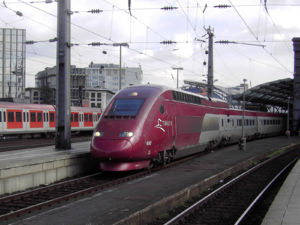
Unlike Thalys PBA sets, the PBKA (Paris-Brussels-Köln (Cologne) -Amsterdam) sets were built exclusively for the Thalys service. They are technologically similar to TGV Duplex sets, but without bi-level carriages. They are quadri-current, operating under 25 kV, 50 Hz AC (LGVs), 15 kV 16⅔ Hz AC (Germany, Switzerland), 3 kV DC (Belgium) and 1,5 kV DC (the Netherlands and French lignes classiques). Their top speed in service is 300 km/h (186 mph) under 25 kV, with two power cars supplying 8,800 kW. When operating under 15 kV power output drops to 4,460 kW, resulting in a very poor power-to-weight-ratio on German high-speed lines. They have eight carriages and are 200 m (656 ft) long, weighing a total of 385 tonnes (424 short tons; 379 long tons). They have 377 seats.
Seventeen trains were ordered, nine by SNCB, six by SNCF and two by NS. Deutsche Bahn contributed to financing two of the SNCB sets.
TGV POS
TGV POS (Paris-Ostfrankreich-Süddeutschland or Paris-Eastern France-Southern Germany) are under test for use on the LGV Est, currently under construction.
They will consist of two power cars with eight TGV Réseau type carriages, with a total power output of 9,600 kW and a top speed of 320 km/h (199 mph). Unlike TGV-A, TGV-R and TGV-D, it has asynchronous motors, and isolation of an individual motor in a powered bogie is possible in case of failure. They will weigh 423 tonnes (466 short tons; 416 long tons).
Network
France has around 1,200 km of LGV, with four lines either proposed or under construction. The current lines and those under construction can be grouped into four routes radiating from Paris:
- West: LGV Atlantique to Tours and Le Mans.
- North: LGV Nord and the Channel Tunnel Rail Link to London, with a branch going towards Brussels.
- East: LGV Est and LGV Rhin-Rhône to Strasbourg
- South: LGV Sud-Est, LGV Rhône-Alpes and LGV Méditerranée to Marseille, plus a branch towards the LGV Perpignan-Figueres.
In addition, the LGV Interconnexion Est connects the the LGV Sud-Est to the LGV Nord around Paris, and the LGV Rhin-Rhône (under construction) will connect Strasbourg and Lyon.
Existing lines
- LGV Sud-Est (Paris Gare de Lyon to Lyon-Perrache), the first LGV (opened 1981)
- LGV Atlantique (Paris Gare Montparnasse to Tours and Le Mans) (opened 1990)
- LGV Rhône-Alpes (Lyon to Valence) (opened 1992)
- LGV Nord (Paris Gare du Nord to Lille and Brussels and on towards London, Amsterdam (HSL-Zuid) and Cologne) (opened 1993)
- LGV Interconnexion Est (LGV Sud-Est to LGV Nord Europe, east of Paris) (opened 1994)
- LGV Méditerranée (An extension of LGV Rhône-Alpes: Valence to Marseille Saint Charles) (opened 2001)
- Channel Tunnel Rail Link Phase 1 (Channel Tunnel to north Kent) (opened 2003)
Lines under construction
- LGV Est (Paris Gare de l'Est-Strasbourg) (will open 10 June 2007)[10]
- LGV Perpignan-Figueres (due to open 2009)
- Channel Tunnel Rail Link Phase 2 (North Kent to London) (due to open 14 November 2007)
- LGV Rhin-Rhône (Strasbourg-Lyon) (due to open 2011)
Planned lines
- Lyon Turin Ferroviaire (Lyon-Chambéry-Turin), connecting to the Italian TAV network
- LGV Sud Europe Atlantique Tours-Bordeaux and LGV Bretagne-Pays de la Loire Le Mans-Rennes, extending the LGV Atlantique (also called LGV Sud-Ouest)
- Bordeaux-Toulouse-Narbonne
- Bordeaux-Spanish border-Vitoria and Irun [1]
- LGV Poitiers-Limoges [2]
- LGV Barreau Picard (Paris - Amiens - Calais), cutting off the corner of the LGV Nord-Europe via Lille.
- LGV Normandie (Paris-Rouen-Le Havre-Caen)
- TGV-ER - Regional line Lille - Aulnoye for high speed service between Lille and Maubeuge
Amsterdam and Cologne are served by Thalys TGVs running on ordinary track, and these connections are being upgraded to high-speed rail. London is served by Eurostar trains running at high speed via the partially-completed Channel Tunnel Rail Link and at normal speed along regular tracks through the London suburbs - Eurostar will use a fully-segregated line once Section 2 of the link is complete in 2007.
TGV technology outside France
TGV technology has been adopted in a number of other countries separately from the French network:
- AVE (Alta Velocidad Española), in Spain
- Korea Train Express (KTX), in South Korea
- Acela Express, a high-speed tilting train built by TGV participant Bombardier for the United States, which uses TGV motor technology (though the rest of the train is unrelated).
Future TGVs
SNCF and Alstom are investigating new technology that could be used for high-speed transport.
The development of TGV trains is being pursued in the form of the AGV, automotrice à grande vitesse (high speed multiple unit). The design has motors under each carriage. Investigations are being carried out with the aim of producing trains at the same cost as existing TGVs with the same safety standards. AGVs of the same length as TGVs could have up to 450 seats. The target speed is 350 km/h (217 mph).
In the short term, plans are being considered to increase the capacity of TGVs by 10% by replacing the central two power cars of a double TGV with passenger carriages. These carriages would have motorised bogies underneath them, as would the first and last carriage of the train, to make up for the lost power. [3]
Safety
In more than two decades of high-speed operation, the TGV has not recorded a single fatality due to accident while running at high speed. There have been several accidents, including three derailments at or above 270 km/h (168 mph), but in none of these did any carriages overturn. This is credited in part to the stiffness that the articulated design lends to the train. There have been fatal accidents involving TGVs on lignes classiques, where the trains are exposed to the same dangers as normal trains, such as level crossings.
On LGVs
- 14 December 1992: TGV 920 from Annecy to Paris, operated by set 56, derailed at 270 km/h (168 mph) at Mâcon-Loché TGV station (Saône-et-Loire). A previous emergency stop had caused a wheel flat; the bogie concerned derailed while crossing the points at the entrance to the station. No one on the train was injured, but 25 passengers waiting on the platform for another TGV were slightly injured by ballast that was thrown up from the trackbed.
- 21 December 1993: TGV 7150 from Valenciennes to Paris, operated by set 511, derailed at 300 km/h (186 mph) at the site of Haute Picardie TGV station, before it was built. Rain had caused a hole to open up under the track; the hole dated from the First World War but had not been detected during construction. The front power car and four carriages derailed but remained aligned with the track. Of the 200 passengers, one was slightly injured.
- 5 June 2000: Eurostar 9073 from Paris to London, operated by sets 3101/2 owned by NMBS/SNCB, derailed at 250 km/h (155 mph) in the Nord-Pas de Calais region near Croisilles. The transmission assembly on the rear bogie of the front power car failed, with parts falling onto the track. Four bogies out of 24 derailed. Out of 501 passengers, seven were bruised[11] and others treated for shock.
On lignes classiques
- 31 December 1983: A bomb allegedly planted by the terrorist organisation of Carlos the Jackal exploded on board a TGV from Marseille to Paris; two people were killed.
- 28 September 1988: TGV 736, operated by set 70 "Melun", collided with a lorry carrying an electric transformer weighing 100 tonnes (110 short tons; 98 long tons) that had become stuck on a level crossing in Voiron, Isère. The vehicle had not been permitted to cross by the French Direction départementale de l'équipement. The weight of the lorry caused a very violent collision; the train driver and a passenger died, and 25 passengers were slightly injured.
- 4 January 1991: after a brake failure, TGV 360 ran away from Châtillon depot. The train was directed onto an unoccupied track and collided with the car loading ramp at Paris-Vaugirard station at 60 km/h (37 mph). No one was injured. The leading power car and the first two carriages were severely damaged, and were rebuilt.
- 25 September 1997: TGV 7119 from Paris to Dunkirk, operated by set 502, collided at 130 km/h (81 mph) with a 70 tonne (77 short ton; 69 long ton) asphalt paving machine on a level crossing at Bierne, near Dunquerque. The power car spun round and fell down an embankment. The front two carriages left the track and came to a stop in woods beside the track. Seven people were injured.
- 31 October 2001: TGV 8515 from Paris to Irun derailed at 130 km/h (81 mph) near Dax in southwest France. All ten carriages derailed and the rear power unit fell over. The cause was a broken rail.
- 30 January 2003: a TGV from Dunkirk to Paris collided at 106 km/h (66 mph) with a heavy goods vehicle stuck on the level crossing at Esquelbecq in northern France. The front power car was severely damaged, but only one bogie derailed. Only the driver was slightly injured.
Following the number of accidents at level crossings, an effort has been made to remove all level crossings on lignes classiques used by TGVs. The ligne classique from Tours to Bordeaux at the end of the LGV Atlantique has no level crossings as a result.
Protests against the TGV
The first environmental protests against the building of a high-speed line in France occurred in May 1990 during the planning stages of the LGV Méditerranée. Protesters blocked a railway viaduct to protest against the planned route, arguing that it was unnecessary, and that trains could use existing lines to reach Marseille from Lyon.[12]
Lyon Turin Ferroviaire (Lyon-Chambéry-Turin), which would connect the TGV to the Italian TAV network, has been the subject of demonstrations in Italy. While most Italian political parties agree on the construction of this line, inhabitants of the towns where construction would take place are vehemently opposing it. The concerns of the protesters centre around storing dangerous materials mined from mountain, like asbestos and uranium, in the open air. This serious health danger could be avoided by using more appropriate but expensive techniques for handling radioactive materials. A six-month delay in the start of construction has been decided in order to study solutions, but a ten-year-old NIMBY national movement against the TAV is trying to exploit inhabitants' legitimate worries to criticize the development of high-speed rail in Italy as a whole.[13]
General complaints about the noise of TGVs passing near towns and villages have led the SNCF to build acoustic fencing along large sections of LGVs to reduce the disturbance to residents, but protests still take place where SNCF has not addressed the issue.[14]
Notes
- ↑ Railway Gazette (November 1 2005) Railway Gazette International 2005 World Speed Survey Tables, Retrieved November 29 2005
- ↑ Alstom (18 December 2006). Alstom commits itself to the French very high speed rail programme. Press release. Retrieved on 2007-02-04.
- ↑ "French high-speed TGV breaks world conventional rail-speed record", Deutsche Presse-Agentur (reprinted by Monsters and Critics), 2007-02-14. Retrieved on 2007-02-14.
- ↑ Le Point (issue 1682, December 9 2004), « Terre des sens » sur de nouveaux rails (in French). Retrieved November 24 2005.
- ↑ The Sunday Times Online (29 May 2005), Party like a pope in Avignon. Retrieved 12 December 2005.
- ↑ Bulletin annuel de l'AFGC (issue 3, January 2001), Les gares nouvelles de Provence du TGV Méditerranée (in French), pp. 49–51.
- ↑ Guardian Unlimited (23 July 2001), Gee whizz! Jonathan Glancey takes in three stunning new TGV stations as he hurtles towards the Cote d'Azur at 200 mph. Retrieved December 13 2005.
- ↑ RAIL (pages 14-15, issue 527, November 23 2005 - December 6 2005), Class 91s to replace GNER's Eurostars
- ↑ RAIL (page 11, issue 529, December 21 2005 - January 3 2006), Double decked trains could be replacement for Eurostars
- ↑ Le Moniteur-Expert (October 24 2005), Fin des travaux de génie civil de la LGV Est européenne (in French). Retrieved November 23 2005.
- ↑ Associated Press (5 June 2000), Eurostar derails; seven passengers bruised. Retrieved 24 November 2005.
- ↑ New Scientist (issue 1719, June 2 1990), High-Speed Protest. Retrieved November 15 2005.
- ↑ Planet Ark (reprinted from Reuters November 1 2005), Environmental Protesters Block French-Italian Railway. Retrieved November 1 2005.
- ↑ Environmental Science and Engineering (November 2001), Train à grande vitesse causes distress. Retrieved November 24 2005.
References
- Soulié, Claude and Tricoire, Jean. Le grand livre du TGV. La Vie du Rail (2002) ISBN 2-915034-01-X (in French).
- Cinotti, Éric and Treboul, Jean-Baptiste. Les TGV européens. ISBN 2-13-050565-1 (in French).
- Perren, Brian. TGV Handbook. ISBN 1-85414-195-3.
- TGV Network Map from tgv.co.uk
- Eurostar Official Site - About Eurostar
- TGVweb, an unofficial website with photos and information
See also
- LGV construction
- TGV world speed record - overview and chronology of speed record attempts
External links
| Wikimedia Commons has media related to: TGV |
- Video of the TGV World speed record at 515,3kmh (320mph)
- Official SNCF Website TGV Operator
- Official TGV Website Run by SNCF
- UK TGV Booking Service Run by RailEurope
- World fastest train
- A lot of photo of the TGV (and other french trains)
- The history of the TGV
- TGV - The French High-speed Train Service at h2g2
- Under the Hood of a TGV from TrainWeb
- TGVweb Accidents page from TrainWeb
- LGV2030: an unofficial website about TGV Network in 2030
- LGV Est
- Railway-Technology
- The TGV
| In Service – France | LGV Sud-Est - LGV Atlantique - LGV Rhône-Alpes - LGV Nord - LGV Interconnexion Est - LGV Méditerranée |
| Under Construction | LGV Est - LGV Perpignan-Figueras - LGV Rhin-Rhône |
| Planned | LGV Bretagne-Pays de la Loire - LGV Provence-Alpes-Côte d'Azur - LGV Poitiers-Limoges - LGV Sud Europe Atlantique - LGV Bordeaux-Toulouse - LGV Barreau Picard - LGV Normandie - Lyon Turin Ferroviaire |
|
High-speed trains: Acela Express • Advanced Passenger Train • AVE • China Railway High-speed • Eurostar • InterCity 225 • InterCityExpress • JR-Maglev MLX01 • HST • HSR-350x • Korea Train Express • Magnetic levitation trains • Pendolino • Shinkansen • TGV • Thalys • Transrapid • Treno Alta Velocità • X2000 | ||
| High-speed lines: Beijing-Tianjin • CTRL (London-Channel Tunnel) • Cologne-Aachen • Cologne-Frankfurt French LGV lines • Hanover-Würzburg • Northeast Corridor (Boston-Washington DC) • Nuremberg-Ingolstadt • HSL 1 (Brussels-Paris) HSL 2 (Leuven-Ans) • HSL 3 (Liège-Aachen) • HSL 4 (Brussels-Netherlands) • HSL-Zuid (Netherlands) Japanese Shinkansen lines | ||
|
By country: Belgium •
Canada • China • France • Germany • Italy • Japan • Korea (South) • Norway • Portugal • Spain | ||
af:TGV cs:TGV cy:TGV da:TGV de:TGV es:Train à Grande Vitesse eu:Train a Grand Vitesse fa:ت ژ و fr:TGV (train à grande vitesse) ko:TGV id:TGV it:TGV he:TGV hu:TGV ms:TGV nl:Train à Grande Vitesse ja:TGV no:TGV pl:TGV pt:TGV ro:TGV ru:TGV war:TGV simple:TGV sk:TGV sl:TGV fi:TGV sv:TGV vi:TGV zh:法国高速列车
